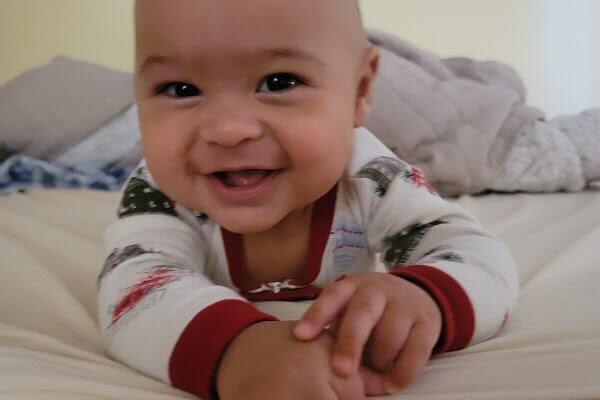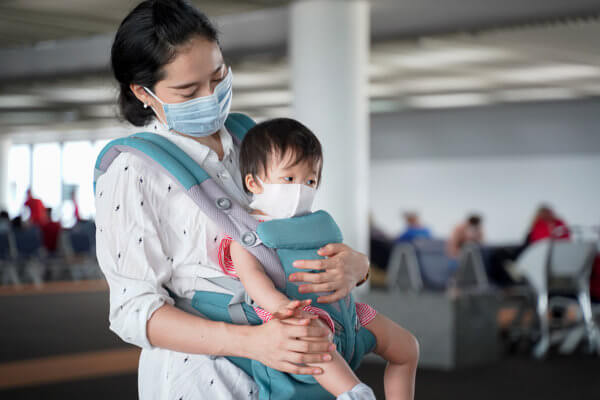By Stacy Whitman
When it comes to diapers, some parents are passionate and opinionated about which is best-cloth or disposable-for them, their babies and the planet. Cost and convenience are two big considerations, as are concerns about the environment and effects on infants’ health and skin. It’s a debate that has been raging for years. But when all the facts are in, both types have pros and cons-so what is ideal for your family may be simply a matter of personal preference. To help you decide, we took a look at the various issues and got the inside scoop.
Consideration #1: Your baby’s health
Search the Internet and you’ll find stories claiming that disposable diapers are loaded with chemicals and toxins that have been linked to everything from asthma to cancer. But despite the scary rumors, there’s no proof that ingredients in disposables are harmful to babies. It’s true that most include a super-absorbent gel called sodium polycrylate (SAP), a substance that was removed from tampons after it was linked to toxic shock syndrome (TSS). However, the SAP in disposable diapers is used inside diapers where it doesn’t come in direct contact with babies’ skin (unlike the offending tampons, which were used internally for extended periods of time), and it has been subjected to rigorous testing and deemed completely safe, according to the American Academy of Pediatrics’ Healthy Children Web site. Also frequently cited is a 1999 study in which several brands of disposables were found to emit gases that caused asthma-like symptoms in mice-but the same effect has never been shown to occur in infants, according to the U.S. Consumer Product Safety Commission. And while some disposable diapers do contain dioxins, by-products of the bleaching process that have been linked to cancer and reproductive problems, a 2002 study found that they are present only in “minute quantities” that aren’t considered worrisome-and some cloth diapers contain just as many.
Another common potential health concern stems from a German study in 2000 that showed considerably higher scrotal temperatures in baby boys wearing disposables versus cloth, which researchers hypothesized could lead to lower sperm counts and fertility problems later in life. However, another study conducted two years later tested cloth diapers with protective covers (which help to prevent leaks) and found scrotal temps on par with disposables, which they also found to be not as high as the German study did. According to Mana Mann, MD, MPH, a pediatric environmental health fellow at Mount Sinai Medical Center in New York, both studies have limitations and no definitive link has been established between use of a specific diaper type and sperm count.
The bottom line: Disposables seem to be getting a bum rap in terms of safety. But if you’re uncertain about these issues and you’d like the convenience and leak-resistant qualities of disposables, there are options: Try a hypoallergenic disposable such as Huggies Pure and Natural, Seventh Generation Chlorine Free or TenderCare Plus, or a plastic-free “hybrid” like gDiapers or GroVia.
Consideration #2: Environmental impact
It’s natural to assume that cloth diapers are more eco-friendly because they are reused instead of being tossed in the trash. But when you consider the complete “lifecycle” of a diaper-factoring in all the energy and water consumed to wash them as well as atmospheric, waterborne and solid wastes created during their production and use-disposables appear to have no greater impact on our environment than cloth.
While numerous studies have examined the environmental issue, only a few can be considered objective (with no ties to the diaper industry). One literature review conducted by the Natural Resources Defense Council (NRDC) in New York back in 1991 found that while disposables use up more raw materials and produce more solid waste, cloth diapers require more energy and water and create more air and water pollution. “From an environmental perspective, you just can’t say one is better than the other,” explains study coauthor and NRDC senior scientist Allen Hershkowitz, PhD.
Another study done in 2008 by the U.K. Environment Agency in Bristol, England, found the global warming impact of cloth diapers slightly higher than that of disposables in their baseline scenario. The researchers noted that the impact of cloth could be as much as 43 percent higher than that scenario if parents tumble-dried all their diapers. Or it could be up to 40 percent lower if they used any three of their suggested eco-minded laundering strategies-which included using energy-efficient appliances, washing fuller loads, keeping water at 140 degrees or lower, line drying and reusing the diapers on other children.
What about new “biodegradable” diapers-“hybrids” consisting of a cloth shell and a disposable inner liner made of all-natural materials? They’ve only been around for a few years, so no fair and balanced study has compared them to regular cloth and disposable diapers. However, there are concerns that they don’t decompose properly in landfills and therefore wouldn’t be helpful if thrown in the trash. However, if composted at home, they might do a world of good.
The bottom line: It’s a toss-up as to which type of diaper is better for the environment. But no matter what you choose, there are steps you can take to reduce the impact on the earth. Cloth diaperers can make a difference by laundering more mindfully and opting for diapers made of unbleached organic cotton (like Bummi’s Organic Cotton Prefolds) and hemp (like FuzziBunz Hemp One Size Pocket Diaper) to reduce use of chemical pesticides and fertilizers. Parents who use disposables can help by dumping poop into the potty instead of the garbage (to reduce the risk of contaminating groundwater) and choosing chlorine-free diapers (which would help decrease the number of dioxins being released) or biodegradable diapers (which won’t pile up in landfills as long as they’re composted).
{pagebreak}
Consideration #3: Convenience
For busy parents who work or simply want to avoid the hassle and “yuck” factor of washing diapers, disposables are the obvious choice. That’s exactly why they were invented decades ago-and why an estimated 95 percent of families are now opting to use them. With their advent, “mommies were no longer tied to the house to change diapers-they could be out and about with an ‘on-the-go’ lifestyle,” points out Carissa Brown, a mother of four in Dallas who has used both disposables and cloth on her kids. However, some cloth diaper advocates contend that laundering them isn’t as difficult or time-consuming as one may think. “With cloth diapers, there’s nothing going into a landfill and they’re easy to clean-one rinse and then a wash cycle and they’re good to go,” says mom Sandy Alexander of Gulph Mills, Pa.
The bottom line: You can’t get much more convenient than disposables.
Consideration #4: Cost
There’s no doubt that disposable diapers are convenient, but that convenience doesn’t come cheap. Most parents average six diaper changes a day and go through nearly 3,000 diapers during their baby’s first year alone, says pediatrician Jennifer Shu, MD, coauthor of The American Academy of Pediatrics’ Heading Home With Your Newborn. By the time your child is potty trained at age 2 or 3, you may have shelled out as much as $1,500 to $2,000 on disposables, according to Consumer Reports. If you use more “eco-friendly” disposables, such as biodegradable or chlorine-free, you can expect to pay even more-an average of $1,600 to $2,500. On the other hand, cloth diapers and accessories (such as waterproof covers and cloth inserts or flushable liners) could cost as little as $500 or up to $1,200, depending on what kind you buy. Tack on a few hundred dollars for laundry detergent, water and electricity if you’re washing them yourself. Reuse the diapers on more than one baby (or sell them after your kid is potty trained), and you’ll really be in the black. Use a diaper service, however, and you’ll probably end up spending as much or just a little less than you would on disposables.
The bottom line: Cloth diapers could save you a bundle as long as you wash them yourself and buy a more economical brand.
Consideration #5: Diaper rash
Cloth diaper proponents contend that chemicals, fragrances, lotions and other ingredients in disposables up the risk of skin irritation. But because disposables are more absorbent, they keep your baby drier and therefore are less likely to cause rashes, the disposable camp argues. Which is it? It could depend on your baby. The same NRDC scientists who examined the environmental impact of diapers also looked at the diaper rash issue-and found some babies responded better to cloth and others to disposables, explains Hershkowitz. While the incidence of diaper rash has increased dramatically since the invention of disposable diapers, most experts agree that there are many different factors that could be coming into play. We do know that excessively wet skin and contact with urine and stool can cause diaper rash-so you should be sure to change your baby quickly after she becomes wet or soiled, especially if you’re using cloth.
The bottom line: If your baby experiences a lot of rashes, you may want to try switching to another type of diaper.
{pagebreak}
Consideration #6: Containment ability
With elastic leg bands, waterproof coverings and super-absorbent gels to absorb wetness, today’s disposables are better than ever at containing messes. Because they’re so reliable, even many parents ardent about using cloth often reach for the disposables when they head out of the house. That said, cloth diapers also have improved dramatically, with new designs, materials and features that boost absorbency and decrease the likelihood of leaks. Some styles, such as All-in-Ones and Pockets, have eliminated the need for waterproof covers, while others (pre-folds, contours and fitteds) still require them. Using absorbent inserts and liners is another way to prevent your baby from soaking through.
Also, how you wash the cloth diapers can greatly affect their absorbency, notes Hillary Mizia, co-owner of Monkey Hugz, a natural parenting and baby store in Golden, Colo. She recommends using no more than a tablespoon of bleach-free detergent and 1/2 cup of vinegar to prevent detergent buildup (which can lead to leaky diapers), and avoiding super-hot water temps (which break down the diapers faster). “Containment is all about the way you put [the diaper] on,” adds Alexander, mom of 1-year-old Brody. “You have to make sure it’s snug around the legs and that the inserts aren’t sticking out of the diaper.”
The bottom line: While cloth diapers have come a long way in the containment department, disposables still rule.
Ultimately, the best diaper is the one that works best for you and your family. So before making a decision, you may want to test different options to see how well they fit your lifestyle and how they affect your baby. Like many parents, you may even find you like using both types-cloth for certain situations and disposables for others. Whatever their impact on Mother Nature, diapers are a necessity of modern life. And before you know it, your baby will be out of them and heading off to school, using a computer, learning to drive, friending you on Facebook and getting his first job. So enjoy the diaper days while they last.
Everything you need to know about cloth and disposables.




